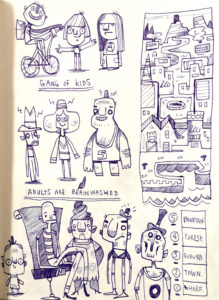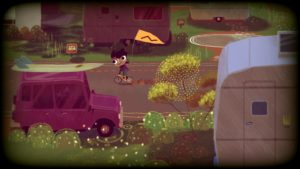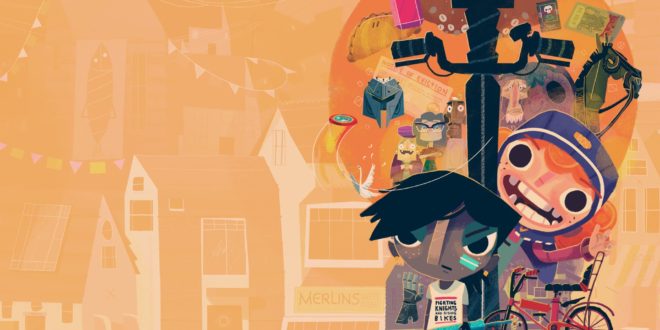
Despite its relatively recent release date of August 2019, Knights and Bikes has already seen enough success to span out into other media: With two books already published, a third on the way and even rumblings of an upcoming TV show. It’s hardly a huge surprise on the face of it, coming off on the back of a hugely successful Kickstarter campaign with a visually distinct style and the excellent (and family-friendly) characterisation of its two leads, Nessa & Demelza.
It’s the family-friendly angle that maybe best explains the game’s broader success, and it’s an angle that informed the game’s central mechanic: narrative driven co-op gameplay, with a particular emphasis on local co-op. While the game is still able to be played solo thanks to an AI-companion, a lot of the game’s initial inspiration came from a lack of story-based co-op games that can be played with families and loved ones, according to Foam Sword co-founders Rex Crowle and Moo Yu.
“Before I moved to the UK,” says Yu “I was a single gamer who played hundreds of hours of games a week on my own. Then once I moved here, I met my wife, and I was always longing for more co-op games. The thing that I felt was really missing was story based co-op games. So either we’d play single player games where we’d pass the controller from person to person, or the other person would just be sitting there and either providing commentary or trying to solve puzzles and giving clues. We just couldn’t find many games where there was a nice story to play through as two characters. I think that was the thing that I eventually sort of started focusing more and more on. Like, what are the kinds of games that I can see myself playing with my wife? Plus I have a son now, and I’m always thinking, once he’s a little bit older, what are the games I can play with him?”
We imagine he and his son could easily just play Knights and Bikes – The game’s focus on the imaginative play of its two child-leads forms much of the game’s character, as well as making it approachable for younger players. This emphasis on childhood takes inspiration from classic coming of age films from the 1980s.
“Like a lot of old school British games,” says Crowle, “the idea formed while we were sitting in a pub one day. We were in this pub on the banks of the Thames, and we were talking about all the stuff that we loved about the movie The Goonies, the way that that’s a real coming of age story. It’s about kids both being individuals but also working together. They have a very strong shared goal of trying to find some treasure, but also that’s just the MacGuffin. The film is really all about them learning to get along with each other. So it started off as this idea of making something similar to that, but also we wanted to put our own spin on it. We didn’t want it to just fall into tropes and nostalgia and what have you. So as the development progressed, we decided to set the set the action in a fictionalised version of Cornwall where I grew up, so it would have kind of quite a different feel to the Oregon setting of The Goonies. I felt that I would be able to contribute a lot more than if I was trying to make a game about somewhere that I hadn’t even visited.”
ARTS AND CRAFTS

This coming of age dynamic isn’t just limited to the game’s narrative, however. The distinctive hand-drawn art style of the game was designed to look as if it had been designed by children, using the kind of materials that children would have easy access to.
“I mean, there’s also some practical reasons for that” says Crowle. “We knew it wasn’t going to be full 3D – that’s definitely not where my skills are, plus with 3D that pipeline just gets so much longer when you’re a small team. So I felt that if we could use 2D artwork in the 3D world setup, it would essentially mean that instead of doing concept art and that just being the start of the process, that actually concept art could be just exported as a static image, loaded into Unity and then stood up in a 3D world.
“But beyond the practical reasons, there was also the question of how that art is going to be created? I felt that creating the world with similar materials to what the kids would have themselves would make it feel a little bit like they are creating the world. They’re telling this story to you when you play it, you’re seeing it slightly through their eyes.
“At the same time, I didn’t want it to have that look you sometimes get in movies, where they want to show like ‘oh, it’s the kid’s drawing on the fridge’ and it’s kind of a wonky house. And then someone always draws like the letter R backwards to show like ‘aw, a kid’s drawn it.’ No kid has ever drawn Rs backwards! That’s just something invented by adults! It still had to look beautiful, but this use of materials helps us to meet halfway between the adult world and the expressive, imaginative kid perspective on that world.”
The pair have proven experience in exploring imaginative, child-friendly spaces like this. As Media Molecule alumni, they both worked on LittleBigPlanet, with Crowle having since gone on to work as the creative director on Tearaway and Tearaway Unfolded. With this pedigree under their belts, the pair felt it was time to step away from Media Molecule and start up their own studio.
“Tearaway was a really fun project,” says Crowle. “I really enjoyed my first time leading a project and being slightly hands off, but also trying to guide the game to fruition. All games are hard to make. And I think after you’ve created a whole universe from scratch, you’re often looking for something new to do and have some new adventures. I think both of us really wanted to make something quite small, quite personal – something that we could work on by going around to each other’s flats and working from kitchen tables.
“Both of us live in London, and Media Molecule is down in Guilford so there was a lot of commuting down there. And I’d done that for well over a decade. So, you know, it felt like it was a good time to really roll up our sleeves and just try and take on making a game and learning about all of the aspects of game making and publishing as well. Things that you don’t have to deal with when you’ve got a whole studio around you making you look actually professional.”
“For me, it’s very similar,” Yu cuts in. “I think, we both did that thing where you rise up the ranks and reach a leadership position, where you have a bit more control and power. But, I think there’s always that moment where you have the nitty gritty of exactly how you want something done, but you’re having to explain it to someone else, writing a spreadsheet or a list that a team is going to implement and that kind of stuff. Just being able to sit down and start typing and get exactly the thing that I wanted, it’s something that I sort of longed for after a couple years of being a product manager.”
BICYCLE BOTHER

Even with all the experience in the world, there’s always going to be development nightmares with such a small team. We ask if anything stands out as a particular problem – As it turns out, it was all the bikes (the knights, apparently, were perfectly fine).
“It took so many tries to get the bikes looking and feeling nice,” notes Yu. “Even though they were 2D, flat objects, we wanted them to feel like they were 3D in the world. We really wanted to make them feel like bikes. It was such a key part of feeling like you’re going out there and exploring the space. I think, if we had moments in there where it felt clunky or it looked really weird, that it would take you out of the experience.
“So there’s this blending of the 2D and 3D, like the behaviour is all 3D, but we’re representing it in 2D assets. And I think the bikes definitely took the most iterations of that. Rex just had to make a tonne of weird abstract animations and have faith that layering six or seven animations on top of each other would actually make a thing that felt like a bike moving in 3D space. Yeah, that definitely took a few tries.”
“Because it’s not just the bike rotating,” adds Crowle. “The front wheel and the steering could rotate independently, and then obviously there’s a character on it as well. So that became a sort of spider’s nest that we were always having to roll up our sleeves and poke at every now and then to try and get it a little bit smoother. I think we got there because while it’s never going to be as smooth as a full 3D system, I think that just adds to the charm. And you can see how much the kids are enjoying the bikes as they’re riding around on them. But yeah, that was definitely kind of a core problem, because obviously the game had bikes in the title. There’s no way that we could just take them out.”
Furthermore, that key period of iteration gets further expanded on once you’re dealing with multiple kinds of co-op play. The game can be played alone with an AI companion, in local co-op and also through online play – each which had to be taken into account.
CO-OP COMPLICATIONS
“One of the things that jumps out at me from a programmer’s perspective,” notes Yu, “was just implementing a game that works as a single player with AI, or local co-op, or online co op as a single programmer on a project. I’m glad it’s done and I’m glad it all works, but it’s just crazy having to program everything three times. It was just so chaotic.
“I remember we had a little section where you lift up the rocks, and like, the amount of times I’ve rewritten how to lift up a rock as two players online and like, what does the co-op player do? What happens if you’re halfway through and you go offline? Why did I sign myself up for this?”
“Plus I would just be just throwing in animations and stuff all the time or just at the last minute,” Crowle cuts in. “Like ‘oh, but we could maybe do some particles here!’ Unity is very, very visual, which is kind of both a good thing and a curse, because then artists can get all in and fiddle around with everything. Which then creates a whole bunch of other tasks, because it has to work as a multiplayer and online. So, yeah, sorry Moo!”
Despite Crowle apparently dooming Yu to an eternal hellscape of rock-lifting, he doesn’t seem to hold it against him too much. Maybe it’s because the pair have seen their hard work pay off in a big way – the game released to widespread critical acclaim, and has proved excellent at bringing families together.
“What was most surprising,” notes Yu, “is how young some of the kids are that people send us images of playing the game. I kind of understood adults would play it with young children, but I assumed that they’re ordering their child around for ten hours. But we see really young children playing it together.
“There’s the Metacritic score and there’s the sales numbers, but you also get to see how it affects people and their relationships.
“My friend’s kids hate each other. They fight all the time. The fact that they were able to sit together for ten hours to play the game tells me what kind of experience we made, and the effects that can have on people. I think that’s something that you always forget when you’re making a game and you’re solving some esoteric online networking bug, but I think that’s a benefit of being in the industry that we’re in.”

 MCV/DEVELOP News, events, research and jobs from the games industry
MCV/DEVELOP News, events, research and jobs from the games industry




